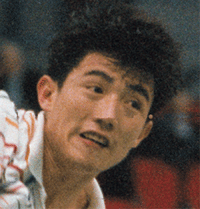|
|

Getting Your Racquet To Perform:
One Pro's Approach
By Steve Crandall
Vice President, Sales & Marketing
Ashaway Racket Strings
I had a talk recently with Ahmad Bakar, president of Singapore-based Pacific Sports, Ashaway's distributor throughout Southeast Asia. Ahmad, a past member of the Singapore National Badminton Team, had recently spoken with one of his top sponsored players, Malaysia's Ong Ewe Hock, about equipment choices, and Ong agreed to go on the record for this article.
 Ong is a Top Five player worldwide (although, following an injury at the Commonwealth Games, he is currently in the Top 15). At that high level of competition, players scrap for the smallest advantage over one another. But Ong doesn't care who copies his equipment choices, because he knows that what's right for him is not necessarily right for anyone else. What is of interest to any player, however, is the thought process behind his decisions. How you find the right equipment setup is more important than any specific manufacturer or model number. Ong is a Top Five player worldwide (although, following an injury at the Commonwealth Games, he is currently in the Top 15). At that high level of competition, players scrap for the smallest advantage over one another. But Ong doesn't care who copies his equipment choices, because he knows that what's right for him is not necessarily right for anyone else. What is of interest to any player, however, is the thought process behind his decisions. How you find the right equipment setup is more important than any specific manufacturer or model number.
So, to get the specifics out of the way: Ong uses a Gosen Roots-2, Model BR3000 racquet, strung with Ashaway Rally® 21 MICRO string, to 23 lb. tension.
Ong is considered a "touch" player-meaning that his game is a bit more oriented toward control, and a bit less toward power, compared to other world-class badminton players. (Compared to the typical U.S. amateur, however, he's a freight train.) To accentuate his control game, Ong has selected a multifilament string, which is slightly stiffer than microfilament strings. (The main difference is in the thickness and number of the core filaments. For an equal string gauge, a multifilament design typically has 1,000 to 2,000 filaments, compared to 3,000 to 5,000 for microfilament designs such as MicroPower™ and MicroLegend™.)
Ong uses moderately tight tension, also to enhance control over the shuttle. Of course, every decision leading to stiffness and control is a move away from flexibility and power. And precisely because he is not among the most powerful of players in his league, Ong needs to gain some power back from the string: hence, his choice of a thin, fairly flexible 21-Micro gauge string (.70 mm), and his moderation in stringing tension. While even thinner 22-gauge strings are available in Southeast Asia, that seems to be pushing the envelope for durability, and pros regularly break them after just one or two points. Durability as a cost issue typically isn't important for sponsored pros like Ong, who can get all the string they want for free. But if your string is likely to snap during any given point, you're probably going to lose a lot of points, and that is important.
Ong brings eight to ten racquets to a tournament, every one of them identical, and every one strung by the same professional stringer. That way, when he breaks a string or a racquet (which happens three of four times per match), he can shift to the next one and obtain identical performance. Again, it's a matter of competitiveness. Ong doesn't want to lose a single point while adjusting to the feel of a new racquet setup. When not playing tournaments, he practices twice a day, six days a week, and restrings his racquets every week. "Always use a professional stringer," he told Ahmad. "They do a much better job getting even tension across the stringbed. This gives better, more consistent performance, and helps extend the life of the racquet."
Ong emphasizes that careful equipment selection can help players make the best use of their skills, but that it can't make them better players. "Practice and dedication are the keys," he said. Beyond that, Ong's heavy training schedule, and his superb physical conditioning, often enable him to outlast opponents who are technically better players, within the context of a grueling, four- or five day tournament.
This article previously appeared in Badminton News / USA.
|